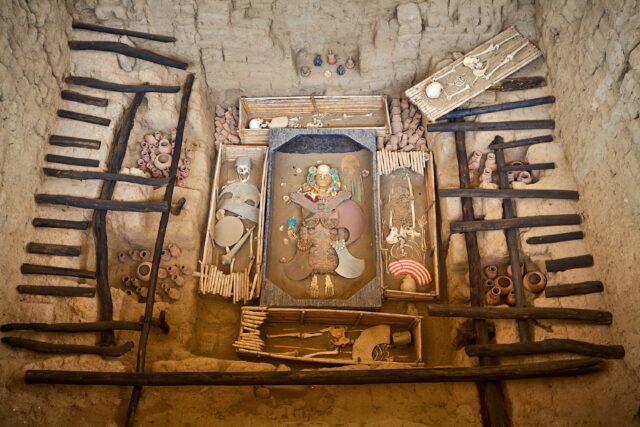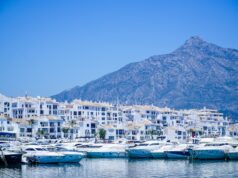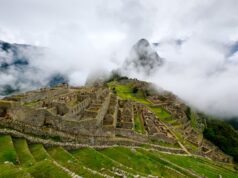The discoveries of the Lord of Sipan and the Lady of Cao marked a milestone in world archaeology, revealing the power, wealth, and mysticism of the pre-Hispanic cultures of northern Peru.
On the northern coast of Peru lie two of the most emblematic archaeological discoveries, both central to different chapters of ancient Peruvian history: the Lord of Sipan, a Mochica ruler from the 3rd century A.D. in the Lambayeque region, and the Lady of Cao, a powerful Mochica leader in the La Libertad region. Both astonish not only for their material value but also for what they reveal about hierarchy, power, and the presence of women in civilizations that flourished more than a thousand years ago.
Why is the Lord of Sipan a Moche symbol?
On July 20, 1987, the discovery of the Lord of Sipan at Huaca Rajada —in the district of Zaña, Lambayeque, 747 kilometers north of Lima— changed the course of Peruvian archaeology. His tomb, found almost completely intact, revealed an extraordinary collection of funerary treasures in gold, ceramics, and precious metals, unmistakably identifying him as a powerful ruler.
The Lord of Sipan stands as a symbol of the Moche culture, embodying the highest political, military, and religious power of this pre-Hispanic civilization that thrived along Peru’s northern coast between the 1st and 7th centuries AD.
Peru’s Ministry of Culture is restoring the replica of the intact tomb, with the goal of preserving the coffins, metal artifacts, ceramics, and skeletal remains, while enhancing the exhibition for visitors.
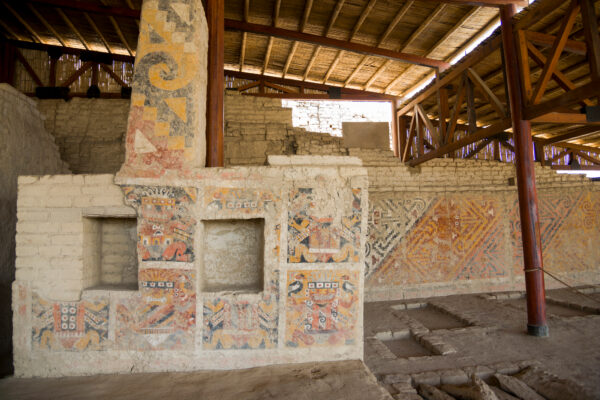
Lady of Cao: A female ruler of the Moche world
The Lady of Cao —also known as the Woman of Cao— was discovered in 2005 at the Huaca Cao Viejo, part of the El Brujo Archaeological Complex, located in the province of Ascope, in the department of La Libertad, 620 kilometers north of Peru’s capital, Lima.
Archaeologists identify her as a woman who held political and religious authority around the 4th century A.D., proving that within Moche culture, female leadership roles with significant power did exist.
Among her burial ornaments were necklaces made of gold, silver, lapis lazuli, quartz, and turquoise, as well as nose ornaments crafted in fine metals and tattoos of snakes and spiders—symbols that expressed power, spirituality, and a deep connection with nature.
Could the Lord of Sipan and the Lady of Cao have been contemporaries?
Recent studies suggest that the Lord of Sipan and the Lady of Cao may have lived during the same period —although separated geographically and socially— opening new questions about the networks of exchange, kinship, and power within the Moche cultures of northern Peru.
In the case of the Lady of Cao, an academic book is currently being prepared with scientific details about her discovery, led by the Lady of Cao Archaeological Project and the Wiese Foundation, in order to deepen and share the results of ongoing research.
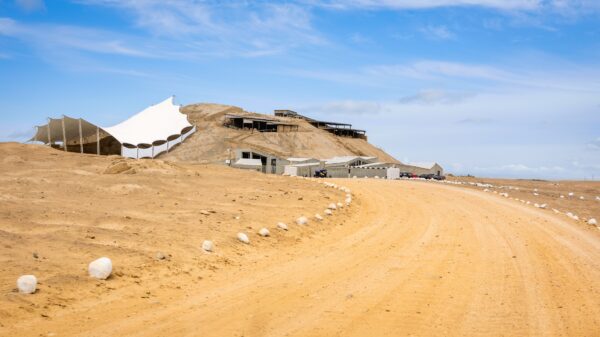
How to visit the Lord of Sipan and the Lady of Cao today
In the Lambayeque region, the Royal Tombs of Sipan Museum houses replicas and artifacts from the funerary context of the Lord of Sipan. Visiting this site offers the best way to experience the legacy of this powerful historical figure.
The museum is located at Avenida Juan Pablo Vizcardo y Guzman 895, Lambayeque. It is open from Tuesday to Sunday, including public holidays, from 9:00 AM to 5:00 PM. Tickets can be purchased directly at the museum’s ticket office.
In northern Peru, in the La Libertad region, you can visit the mausoleum of the Lady of Cao, one of the most powerful rulers of the ancient Moche culture. It is located in the impressive Huaca Cao Viejo, part of the El Brujo Archaeological Complex, open to the public daily from 9:00 AM to 4:00 PM. During the tour, you will discover seven themed halls that showcase her life, the symbols of power that surrounded her, her role in society, and the lasting mark she left on Peru’s cultural identity. This visit is the perfect opportunity to connect with the history and mysteries of the Moche civilization.
Article published on behalf of MarcaGo, and images were provided by MarcaGo, commercially licensed from Shutterstock

